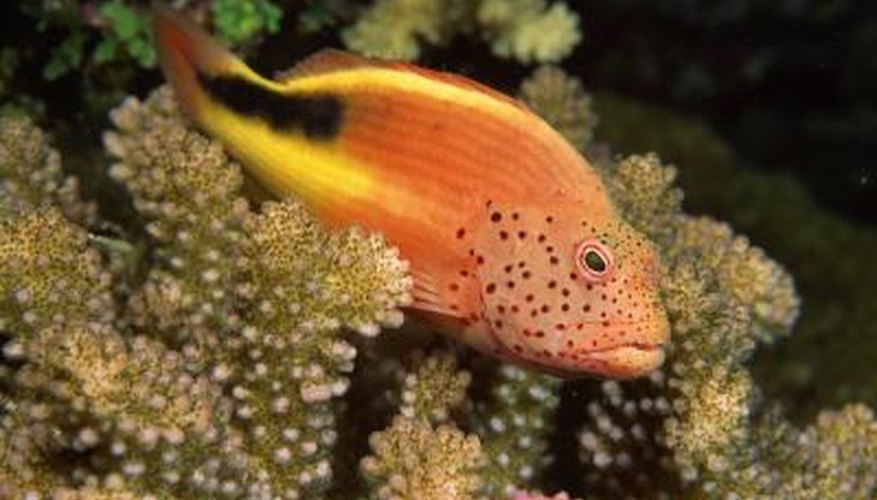Phosphate is found in many things such as water and food and will build up in both freshwater and saltwater aquarium systems. It is a primary fertiliser for nuisance freshwater and saltwater algae. The build-up of aluminium in the aquarium can come from tap water, aluminum oxide filters and presence of aluminium metals on objects and is toxic to fish in large amounts. Removal of both chemicals can be accomplished with different methods, and sometimes in the same way.
- Phosphate is found in many things such as water and food and will build up in both freshwater and saltwater aquarium systems.
- The build-up of aluminium in the aquarium can come from tap water, aluminum oxide filters and presence of aluminium metals on objects and is toxic to fish in large amounts.
Use clean source water that is free of phosphates. Tap water often contains phosphates and other undesirable compounds. Through water changes and top-offs you can add phosphate to the water by using tap water. A good solution to this is to use distilled water or reverse osmosis/deionised water (RODI or RO/DI). Distilled water can usually be purchased at a grocery store and this may work for small aquariums, but the cost would be substantial to use distilled water for a larger aquarium. Instead, you can purchase a RODI filter and use it to create purified water for your system.
Install a protein skimmer. A protein skimmer mixes air with water and removes organic compounds. Skimmers only work with salt water, so fresh water aquariums should use alternative methods. Skimmers will remove organic phosphate compounds before they break down into inorganic phosphate compounds.
Add green plants or macroalgae. Phosphate is a fertiliser for both plants and macroalgae and deliberately adding these to your aquarium can reduce phosphate. For saltwater aquariums, macroalgaes such as Chaetomorpha sp. and Caulerpa racemosa can help pull phosphate from the water. For freshwater applications, plants such as the Amazon swords can accomplish the same thing. These plants and algae can be grown in the aquarium or in a separate filtration system (a sump).
- Install a protein skimmer.
- Phosphate is a fertiliser for both plants and macroalgae and deliberately adding these to your aquarium can reduce phosphate.
Add a chemical phosphate remover. There are products on the market that use various compounds to remove inorganic phosphate from the water. Chemical removal of phosphate can be a great short-term fix to the phosphate problem, but skimming, plants and macroalgae are more effective (and less expensive) long-term solutions. Some phosphate removing additives use aluminum oxide and will cause a build-up of aluminium in the water.
- Add a chemical phosphate remover.
- There are products on the market that use various compounds to remove inorganic phosphate from the water.
Use purified water for water changes and top-offs. Just as with phosphate, tap water can contain aluminium and sometimes other heavy metals. Water treatment facilities frequently use aluminium sulphate to clarify water. The best way to assure these don't make it into your aquarium is to use either distilled or RODI water.
Add peat moss to your filtration system. This works for freshwater applications as the peat moss will absorb the aluminium from the water system. It takes time for it to work, so pass the water slowly through it. Peat moss is not desirable for saltwater systems.
Install a protein skimmer. For saltwater applications, using a protein skimmer has been shown to remove some aluminium. The aluminium binds to organic materials that can be removed by skimming the water. Skimming will also help reduce other undesirable compounds.
- Add peat moss to your filtration system.
- For saltwater applications, using a protein skimmer has been shown to remove some aluminium.
Grow mangroves in the aquarium water. Mangroves take up some aluminium and other heavy metals and have been used to clean up toxic waste water. The mangroves may not remove much aluminium but they will help. Mangroves can be planted in the aquarium itself or in a supplemental filtration system like a sump. Remember that mangroves are trees and will need to be occasionally cut back.
Plant Caulerpa sp. macroalgae. In a study by Dr. Ron Shimek, caulerpa macroalgae was shown to contain some aluminium absorbed from the water. Caulerpa grows only in salt water and is an excellent choice for removing phosphates and nitrates from the water system as well.
- Grow mangroves in the aquarium water.
- Caulerpa grows only in salt water and is an excellent choice for removing phosphates and nitrates from the water system as well.
TIP
Phosphates are sometimes used to cure and preserve fish. Use caution if you are making your own fish food from store-bought fish as you may be adding phosphates in large quantities. Phosphate test kits do not show all the types of phosphate present in the system since the plants and algae will absorb the phosphate rapidly. However, if you have an algae problem in the aquarium, high phosphate is likely playing a role. Never add aluminium (such as aluminium foil) to the aquarium system.
